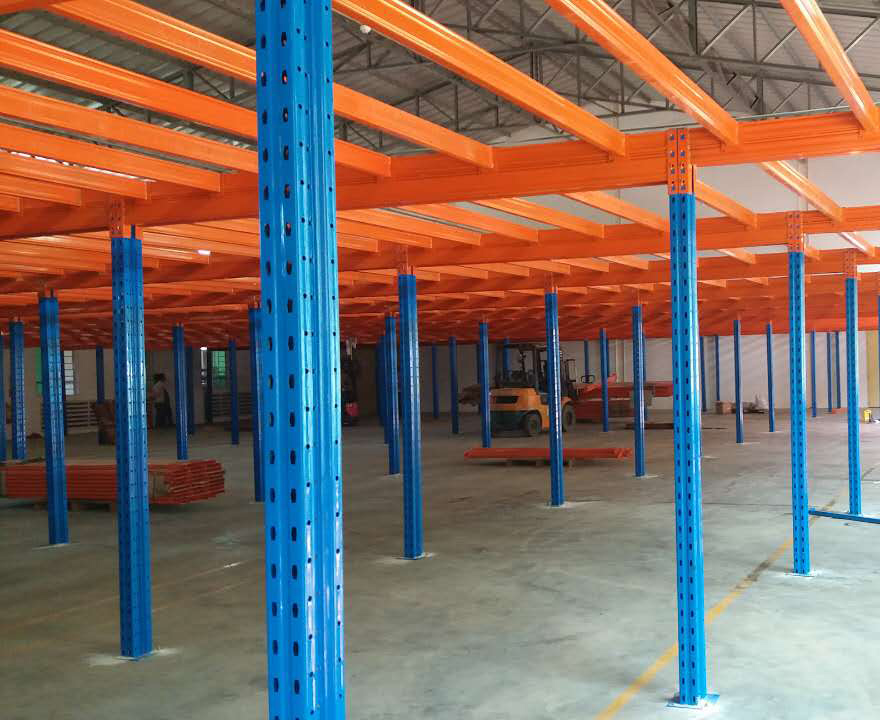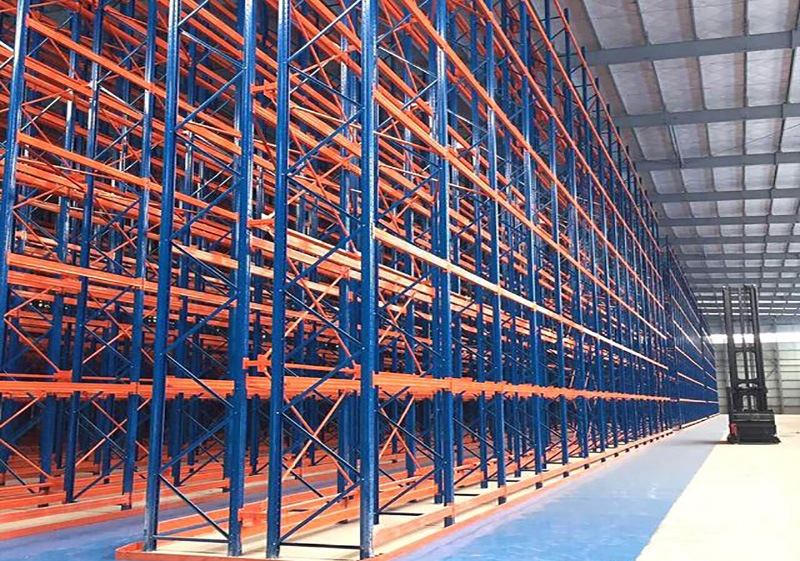For warehouse managers and business owners squeezed by rising real estate costs, maximizing storage density isn't just smart – it's essential. Mobile pallet racking systems offer a compelling solution, dramatically increasing pallet positions within the same footprint. Naturally, understanding the investment required is paramount, and that's where analyzing the mobile pallet racking system cost per square foot becomes critical. This comprehensive guide breaks down the key factors influencing this metric, helping you make an informed financial decision.

While a simple price tag per bay exists, the mobile pallet racking system cost per square foot provides a more meaningful comparison, especially when evaluating against traditional static racking or the cost of acquiring additional warehouse space. This metric factors in the system's ability to store significantly more pallets in the same floor area. However, arriving at an accurate figure involves peeling back multiple layers.
The core mobile pallet racking system cost per square foot starts with the physical components:
Carriages (Bases/Movers): These are the motorized or manually propelled units that run on floor rails. They constitute a major portion of the cost. Prices vary based on load capacity (e.g., 2,500 lbs vs. 6,000 lbs per beam level), construction (galvanized steel, paint finish), drive mechanism (manual crank, mechanical assist, electric), and safety features. Higher capacities and electric drives increase the cost per square foot.
Upright Frames & Beams: While similar to static racking, mobile systems often require slightly heavier-duty frames to handle dynamic loads and potential rack-on-rack scenarios in very tall systems. Beam length and gauge also impact price. The density achieved (number of pallet positions per aisle) directly influences the final mobile pallet racking system cost per square foot – higher density lowers the effective cost per pallet position and per sq ft of floor space utilized.
Floor Rails: Heavy-duty steel rails are embedded into the floor to guide the carriages. Cost depends on rail length, gauge (thickness), and the complexity of the layout (straight runs vs. turns). Proper rail installation is non-negotiable for safety and performance.
Control System (Electric Systems): For powered systems, this includes motors, gearboxes, control panels, wiring, and potentially safety sensors. This adds significantly to the upfront cost per square foot compared to manual systems but offers major operational benefits.
Component Cost Range (Approximate): $45 - $65+ per sq ft of system footprint (excluding installation). This is highly variable based on specs.
Installation is a major factor in the total mobile pallet racking system cost per square foot. It's typically more complex and time-consuming than static racking:
Site Preparation: Requires precise floor leveling and potentially minor concrete work to ensure rail stability. Existing floor conditions can dramatically impact this cost.
Rail Embedment: Accurately cutting slots into the concrete floor, placing and leveling the heavy rails, and securing them with epoxy grout is labor-intensive and requires specialized skills and tools.
System Assembly: Building the carriages and assembling the racking frames onto them is more intricate than standalone static racks.
Electrical Work (Powered Systems): Running conduit, wiring motors and controls, and integrating with building power adds complexity and cost.
Safety System Integration: Installing aisle-end barriers, warning lights, and sensors adds to the labor component.
Installation Cost Impact: Can add $15 - $30+ per sq ft to the total project cost per square foot. Simpler, smaller manual systems will be at the lower end; large, complex, powered systems with significant site prep at the higher end.

The true mobile pallet racking system cost per square foot must consider ongoing operational expenses:
Energy Consumption (Powered Systems): Electric movers consume power, especially during peak shifting times. While generally efficient per pallet moved due to density gains, it's a recurring cost.
Maintenance: Mobile systems have moving parts (wheels, bearings, gears, motors) that require regular inspection, lubrication, and eventual replacement. Preventative maintenance contracts are common and advisable. Neglecting maintenance drastically increases long-term costs and safety risks. Factor in $0.50 - $2.00+ per sq ft annually for planned maintenance.
Potential Repairs: Components like drive motors, gearboxes, or control boards can fail and need repair or replacement. Downtime can also be a hidden cost.
Operational Efficiency: While mobile systems save labor by eliminating fork truck travel in aisles, moving an entire aisle requires operator time. Training staff on safe operation is crucial and incurs a cost. However, the net labor cost per pallet stored or retrieved is usually lower than in static warehouses with long travel distances.
Evaluating mobile pallet racking system cost per square foot purely as an expense misses its core value proposition: massive space savings translating to tangible financial benefits:
Density & Space Savings: Mobile systems typically increase storage density by 50-100% compared to static racking with wide aisles. This means storing the same number of pallets in potentially half the floor space. Calculate the value of avoided costs:
Avoided Rent/Lease Costs: If adding a mobile system prevents you from leasing an additional 10,000 sq ft at $10/sq ft/year, that's $100,000 saved annually. This directly offsets the mobile pallet racking system cost per square foot.
Avoided Construction Costs: Building or expanding a warehouse is extremely expensive ($100-$200+ per sq ft). Mobile racking defers or eliminates this massive capital outlay.
Reduced Utility Costs: Heating, cooling, lighting, and taxing a smaller footprint lead to significant ongoing savings.
Improved Productivity: Faster access to pallets (no driving down long aisles), especially in powered systems, can increase throughput and reduce labor hours per pallet handled.
Enhanced Inventory Control: Denser storage often leads to better organization and potentially reduced picking errors.
Value Proposition: While the upfront cost per square foot is higher than static racking, the dramatic reduction in required square footage often results in a lower total project cost and a compelling ROI, especially in high-cost real estate markets.
Putting the mobile pallet racking system cost per square foot into context requires comparison:
vs. Traditional Wide-Aisle Static Racking:
Static Racking Cost: $25 - $45 per sq ft (installed, basic selective).
Mobile Racking Cost: $60 - $95+ per sq ft (installed).
Key Difference: While mobile has a higher cost per square foot of system footprint, it stores 2-3x more pallets in that same footprint. Therefore, the cost per pallet position and the cost per pallet stored per year (factoring in real estate) is often significantly lower for mobile systems.
vs. Narrow-Aisle (NA) or Very-Narrow-Aisle (VNA) Static Racking:
NA/VNA Racking Cost: $35 - $60+ per sq ft (rack only).
NA/VNA Equipment Cost: Requires specialized reach trucks or turret trucks ($60,000 - $150,000+ each) and often wire guidance.
Comparison: NA/VNA achieves high density but requires expensive equipment, highly trained operators, and very flat floors. Mobile offers similar density without the specialized lift equipment, often at a comparable or lower total cost per square foot of storage capacity when equipment is included. Mobile also provides direct access to every pallet.
vs. Automated Storage & Retrieval Systems (AS/RS): AS/RS has a vastly higher upfront cost per square foot ($150 - $400+) but offers maximum density and automation for very high-throughput facilities. Mobile racking is a more cost-effective semi-automated solution for many operations.
Arriving at a meaningful figure for your project involves:
Define Scope: Exact layout, number of aisles, rows, levels, beam lengths, load capacities, manual vs. powered.
Get Detailed Quotes: Obtain quotes from reputable suppliers including all components and professional installation.
Calculate Total Project Cost: Sum of all equipment, installation, freight, taxes, and necessary site prep.
Calculate System Footprint: Total floor area covered by the mobile racks (Length x Width of the entire block).
Cost per Sq Ft (Footprint): Total Project Cost / System Footprint Sq Ft = Base Mobile Pallet Racking System Cost Per Square Foot.
Calculate Storage Density: Total number of pallet positions.
Cost per Pallet Position: Total Project Cost / Total Pallet Positions. This is often the most telling metric.
Factor in Operational Costs: Estimate annual maintenance and energy.
Calculate Value of Space Saved: Estimate the annual cost (rent, utilities, taxes) of the square footage you didn't need because of the mobile system's density. Deduct this annual saving from the operational costs for a net operational view.
ROI Calculation: (Annual Savings from Avoided Space + Productivity Gains - Annual Operational Costs) / Total Project Cost. A typical ROI for mobile racking in space-constrained areas is 2-5 years.
Real-World Example:
Scenario: Need to store 2000 pallets. Static wide-aisle requires 10,000 sq ft. Mobile racking requires only 5,500 sq ft.
Static Cost: 10,000 sq ft * $35/sq ft = $350,000.
Mobile Cost: 5,500 sq ft * $75/sq ft = $412,500. (Higher cost per sq ft footprint).
Cost Per Pallet Position (Static): $350,000 / 2000 = $175.
Cost Per Pallet Position (Mobile): $412,500 / 2000 = $206.25. (Slightly higher).
Real Estate Savings: Avoiding 4,500 sq ft of leased space @ $12/sq ft/year = $54,000 saved annually.
Net Annual Operational Cost (Mobile): Estimate $8,000 (maintenance, energy) - $54,000 (space saving) = -$46,000 (Net Annual SAVING).
ROI: $46,000 (Annual Net Saving) / $412,500 (Project Cost) = ~11% ROI or payback in under 9 years. This doesn't even factor in potential productivity gains.
Focusing solely on the initial mobile pallet racking system cost per square foot of its footprint provides an incomplete picture. While undeniably higher than basic static racking, the transformative space savings are where the true financial advantage lies. By potentially doubling your storage capacity within the same four walls, mobile racking dramatically reduces or eliminates the need for expensive warehouse expansion or relocation. The resulting savings on rent, construction, utilities, and property taxes often quickly offset the higher initial investment, leading to a compelling return on investment and a significantly lower effective cost per pallet stored over the system's lifetime.
When evaluating mobile pallet racking system cost per square foot, prioritize a holistic analysis. Consider the total project cost, the achieved storage density (cost per pallet position), the quantifiable value of the space saved, operational efficiencies, and long-term maintenance. For warehouses battling space constraints in costly real estate markets, mobile pallet racking isn't just a storage solution; it's a strategic investment that leverages vertical space and minimizes your most expensive asset – your floor space – delivering substantial financial benefits that far outweigh the initial price per square foot.
 Wechat
Wechat
 Whatsapp
Whatsapp